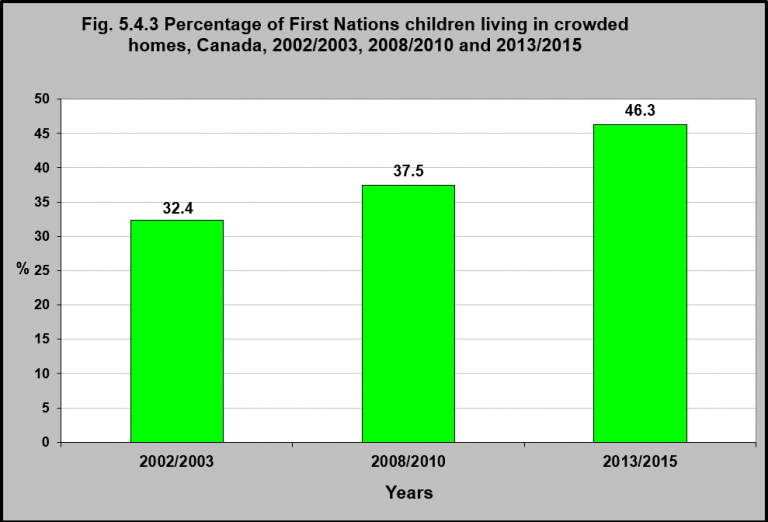Percentage of First Nations children living in crowded homes, Canada, 2002/2003, 2008/2010 and 2013/2015

Source: CICH graphic created using data adapted from First Nations Information Governance Centre, Our Data, Our Stories, Our Future: The National Report of the First Nations Regional Early Childhood, Education and Employment Survey. 2016. http://fnigc.ca/sites/default/files/docs/fnigc_fnreees_national_report_2016_en_final_28072016_0.pdf -accessed August 25, 2017 and the First Nations Regional Longitudinal Health Survey (RHS) 2008/10, National report on adults, youth and children living in First Nations Communities. https://fnigc.ca/sites/default/files/docs/first_nations_regional_health_survey_rhs_2008-10_-_national_report.pdf -accessed August 2, 2017.
In 2013/2015, according to the First Nations Regional Early Childhood, Education and Employment Survey, 46.3% of First Nations children were living in crowded homes1 – that is homes having more than one person per habitable room.2
This was up from 37.5% in 2008/2010 and 32.4% in 2002/2003, according to the First Nations Regional Longitudinal Health Survey.
First Nations households had an average of 5.7 persons (2.4 adults and 3.4 children and youth).3
First Nations households with children had almost three times as many children as households in the general Canadian population – 3.2 vs. 1.1.4
1First Nations Information Governance Centre, Our Data, Our Stories, Our Future: The National Report of the First Nations Regional Early Childhood, Education and Employment Survey. 2016. http://fnigc.ca/sites/default/files/docs/fnigc_fnreees_national_report_2016_en_final_28072016_0.pdf-accessed August 25, 2017.
2Statistics Canada. 2006 Census: Aboriginal Peoples in Canada in 2006: Inuit, Metis and First Nations. http://www12.statcan.ca/census-recensement/2006/as-sa/97-558/note-eng.cfm-accessed August 22, 2017.
3Jackson, A., & Roberts, P. (2001). Physical housing conditions and the well being of children. Ottawa: Canadian Council on Social Development. http://www.peelearlyyears.com/pdf/Physical%20Housing%20Conditions%20and%20the%20Wellbeing%20of%20Children,%20Canada.pdf-accessed August 3, 2017.
4Statistics Canada. (2007). Census families by number of children at home, by province and territory (2006 Census). http://www5.statcan.gc.ca/olc-cel/olc.action?objId=97-553-X2006009&objType=46&lang=en&limit=0-accessed June 12, 2017.
Implications
It has been recognized for decades that the state of housing in First Nations reserves has been poor. Despite this recognition, and numerous initiatives to improve the quantity, quality and affordability of First Nations housing, the proportion of First Nations children living in overcrowded housing conditions has been steadily increasing. This is placing many First Nations children at risk of poorer health outcomes, including respiratory illnesses, injuries, poorer mental health and well-being, and developmental delays.
